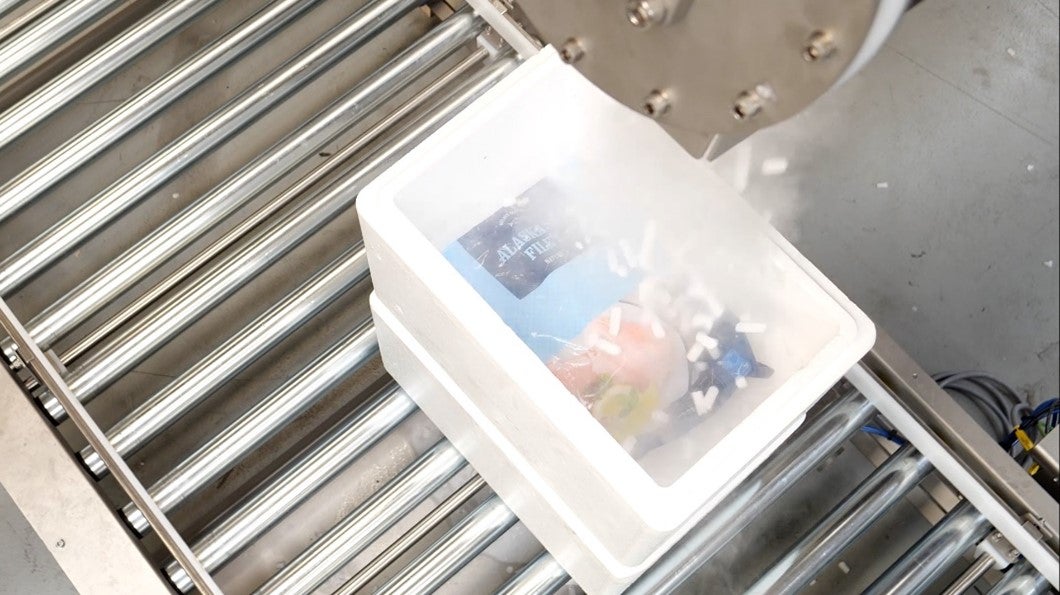
When shipping perishable goods, selecting the right cooling medium is critical to a successful last mile strategy. The optimal cooling medium for shipping perishable goods is dry ice. Due to its unique features, dry ice offers many benefits for the last mile process. It’s safe around food, it has a high cooling coefficient, and it’s environmentally friendly.
Dry ice is a one-way solution, meaning it sublimates back to gas and leaves no waste. There are many different formats, sizes, and shapes of dry ice that can be used based on the goods that are being shipped, distance traveled, and space constraints of shipping containers. Dry ice production units are capable of creating a variety of different formats, sizes, and shapes of dry ice depending on your needs.
Our dry ice production solutions can be integrated into your pick line and automated with dosing and metering systems that allow for the production of preprogramed amounts of dry ice to be dosed directly into parcels.
Just-in-time dry ice production
Producing dry ice on-site guarantees just-in-time supply of a cooling medium that is more efficient than any other on the market. Whether your operation is best suited for slices, nuggets (10-16mm) or pellets (3mm), taking control of your cold chain operations by integrating a dry ice manufacturing solution into your pick line is easier than it looks.
A one-way solution
Dry ice is an effective cooling medium for many reasons. One reason is that it maintains a consistent temperature of -109°F (-78.9°C). This allows companies to ship perishable goods and pharmaceuticals at ultra-cold temperatures (such as the COVID-19 vaccine) with confidence. Since it does not melt, there is no water or residue left behind. Instead, it sublimates, or turns right back to its gaseous state.
Dry ice is also more fuel-efficient than traditional cooling methods because it losses weight during the sublimation process. Lastly, it is more environmentally sustainable as it does not require additional refrigerants which release harmful pollutants into the atmosphere.
Minimize spoilage while shipping perishable goods
Food spoilage rates double for each 10°C rise. Adding dry ice to your parcels can guarantee peace of mind for your delivery operations. Producing your own dry ice gives you greater control over your production, processing and cold chain management operations while reducing waste and operating costs.
Dry ice vs gel packs
Alternative cooling methods, which include gel packs and refrigerated trucks, have their drawbacks. While gel packs are easier to store and handle than dry ice, they raise serious environmental concerns. Gel packs create a tremendous amount of waste and are difficult to recycle. Most consumers will simply throw the packs away but, some environmentally conscious consumers may attempt to recycle them which can be a difficult task. In most areas, they can only be recycled in designated locations. Some companies offer recycling programs which allow customers to return gel packs free of charge.
While this results in some gel packs being recycled, it introduces a considerable amount of added cost and environmental concerns surrounding the return shipment, sanitization, and re-cooling of the gel packs.
Dry ice vs refrigerated trucks
Another cooling option is the use of refrigerated trucks. This option can provide the appropriate cooling, without the added step at the distribution center of applying a cooling medium into the packages. This process presents logistical issues and raises serious concerns about its environmental impact. Perishable goods must be cooled constantly or they will change temperature immediately. This becomes an issue when items are loaded onto the truck and unloaded for delivery. Poor loading practices often leave perishable foods sitting on the loading dock longer than permissible, resulting in a large percentage of goods loaded onto trucks at the wrong temperatures.
There is also a risk of equipment failure and driver error, which could result in a complete loss of refrigeration or the goods being kept at the wrong temperature. Refrigerated trucks are the least environmentally sustainable option. They can use up to 25% more fuel than traditional trucks and release a significantly higher amount of polluting particulate, such as refrigerant chemicals and nitrogen oxides. Cities are also beginning to introduce regulations to limit fuel-powered trucks in city centers. Many cities are beginning to institute low emission zones, which charge an entrance fee to fuel-powered cars and trucks. The use of electric trucks greatly reduces the impact on the environment, but they are constrained by radius and battery power and are often not viable, unless utilizing dry ice as a cooling medium.
Sustainability of dry ice
Put simply, dry ice is the solid form of CO2. CO2 is a naturally occurring gas in our atmosphere, but for the purposes of sustainability, recycled CO2 is used to make dry ice. Dry ice maintains a temperature of -109° F (-78° C) and sublimates back to gas. This means that unlike water ice, dry ice will not leave behind any liquid.
Dry ice is the most sustainable and efficient refrigeration medium for keeping temperature-sensitive products cold. Dry ice is the product of a carbon capture and utilization (CCU) process. CO2 is captured in industrial and biogas facilities, recycled and converted into dry ice. The CO2, which would otherwise have been disposed of as waste, has a second life as a cooling and cleaning medium.
Carbon capture & utilization process
Dry ice is colorless, tasteless, and odorless and is approved for use around food by the EPA, FDA and USDA.
Easier to produce than you think
Dry ice continues to be the most effective cooling medium for last mile deliveries and allows for optimal control and efficiency during the production process, all while being environmentally sustainable.
Interested, but not sure where to start? Contact Ben Shepard, our Commercial Director specializing in Cold Chain Dry Ice Production projects for food home delivery today!

